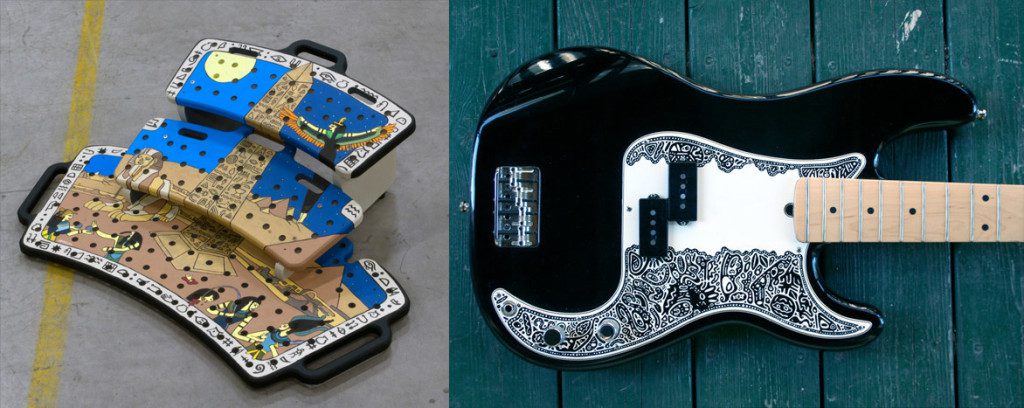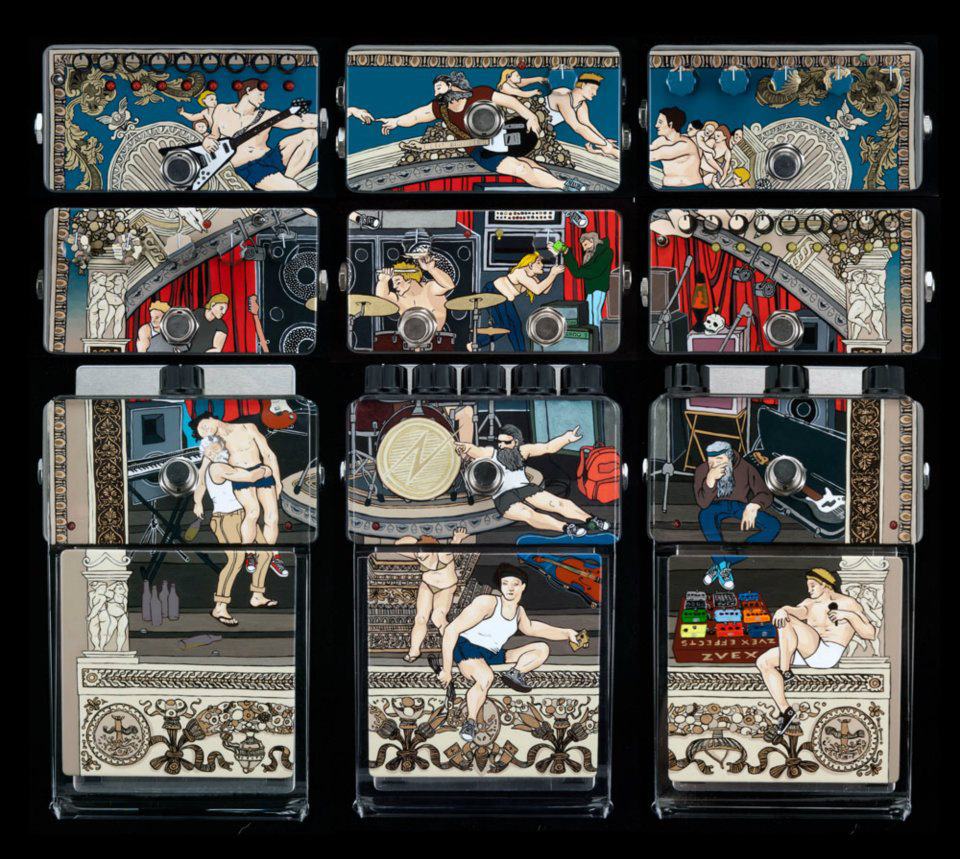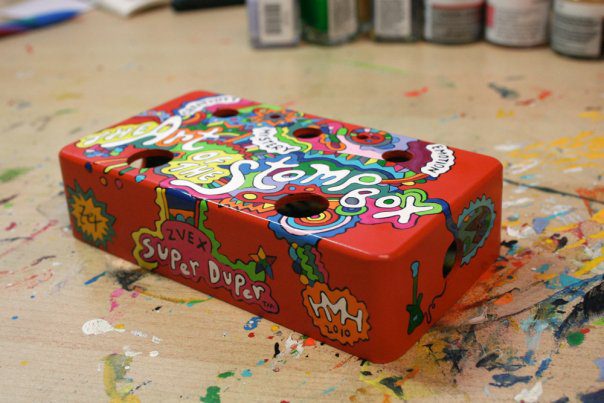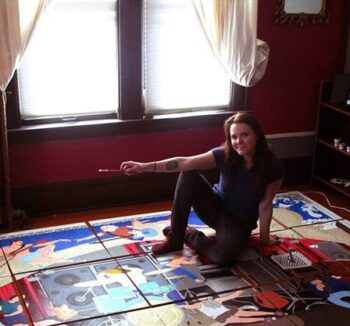
Welcome back to Sound & Vision, the Rumpus profile series that spotlights the creative talents of those working behind the scenes in the music industry. A few months ago, I did a story for NPR on guitar pedals—small metal boxes that make the guitar sound “fuzzy” by distorting its sound. It was great fun to trace the history of guitar pedals, and to talk with folks who make them and the musicians who use them to customize guitar sounds. But on the radio I wasn’t able to talk about the extraordinary visual aesthetics of the pedals. Not only do pedals have great names like Fuzz Face, Voodoo-Axe, and Mastotron, but they’re also beautiful objects of art—some are covered with fur, others look like retro scientific devices, and still more are hand-painted and customized with intricate lettering and lush optics.
 The pedals customized by Hannah Haugberg are among my favorites. Haugberg was until very recently an in-house artist at Z.Vex Effects, a top pedal maker based in Minneapolis. During her seven years with the company she designed thousands of pedals for musicians including Sean Lennon, Pharrell Williams, J. Mascis (Dinosaur Jr.), Nels Cline (Wilco), Henry Kaiser, Noel Gallagher (Oasis), Justin Sharbono (Soul Asylum), SUNN O))), Kyle Hunt (The Black Angels), and the Aquabats. Beyond her work with pedals, Haugberg has also done album art, posters, and gear designs for musicians and bands, as well as work for Modern Radio and other recording labels. She has also produced many other creative projects involving papier mâché, sign painting, macramé, and ceramics. Haugberg and I recently had the chance to talk about how she came to her work with Z. Vex, and where she plans to take her art next.
The pedals customized by Hannah Haugberg are among my favorites. Haugberg was until very recently an in-house artist at Z.Vex Effects, a top pedal maker based in Minneapolis. During her seven years with the company she designed thousands of pedals for musicians including Sean Lennon, Pharrell Williams, J. Mascis (Dinosaur Jr.), Nels Cline (Wilco), Henry Kaiser, Noel Gallagher (Oasis), Justin Sharbono (Soul Asylum), SUNN O))), Kyle Hunt (The Black Angels), and the Aquabats. Beyond her work with pedals, Haugberg has also done album art, posters, and gear designs for musicians and bands, as well as work for Modern Radio and other recording labels. She has also produced many other creative projects involving papier mâché, sign painting, macramé, and ceramics. Haugberg and I recently had the chance to talk about how she came to her work with Z. Vex, and where she plans to take her art next.
***
The Rumpus: How did you first get into design and illustration?
Hannah Haugberg: I went to Minneapolis College of Art and Design and graduated with a BFA in graphic design in 2007. I didn’t do much illustration work in college because I was more focused on infographics, mapping, and signage. Toward the end of my collegiate career I did a lot of sign painting and lettering and fonts. I got really into the custom illustration and lettering when I started working at Z. Vex.
Rumpus: How did you find the job?
Haugberg: I had just graduated from college and I was working downtown at a marketing firm. When that ended I decided to delve into work for non-profits and small businesses, but my roommate at the time was a contract painter for Z. Vex, and she told me they were looking for a full-time painter. I had a lot of experience with lettering enamel, and a friend of mine had painted my 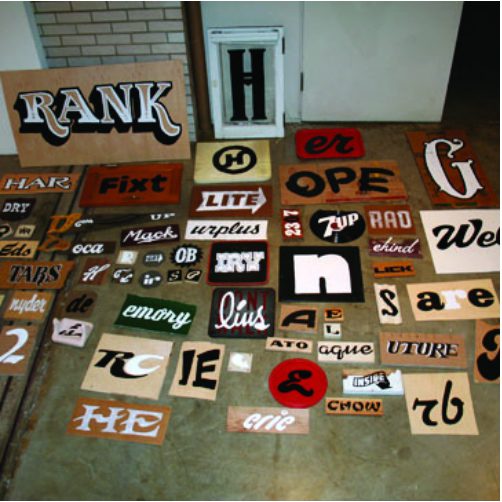 car with it. I showed up to my interview with this giant painted car and Zach [Vex] basically hired me right on the spot. It was really sweet!
car with it. I showed up to my interview with this giant painted car and Zach [Vex] basically hired me right on the spot. It was really sweet!
Rumpus: I’d love to see that car. Do you still have it?
Haugberg: [Laughs] It actually went missing at one point. I’d gone out for drinks with a friend and left it at the bar because I lived a couple of blocks away and didn’t want to drive it home. But I’d parked it on the wrong side of the street, and when I went to get it the next morning I discovered it had been parked in a tow zone. I went to the impound lot, but they said it wasn’t there. It had been entered into the system wrong, so I had to fill out a police report, et cetera, and two weeks later I was still driving around the outside of the impound lot looking for my giant painted car. I posted pictures of me with the car all around town, and I’d told everyone it was lost. It was sad!
Rumpus: Were you doing custom designs for Z. Vex right from the start or was that something that developed over time?
Haugberg: In the beginning my co-worker Lisa McGrath and I were painting the same design over and over again. Then people started emailing us all the time asking for custom one-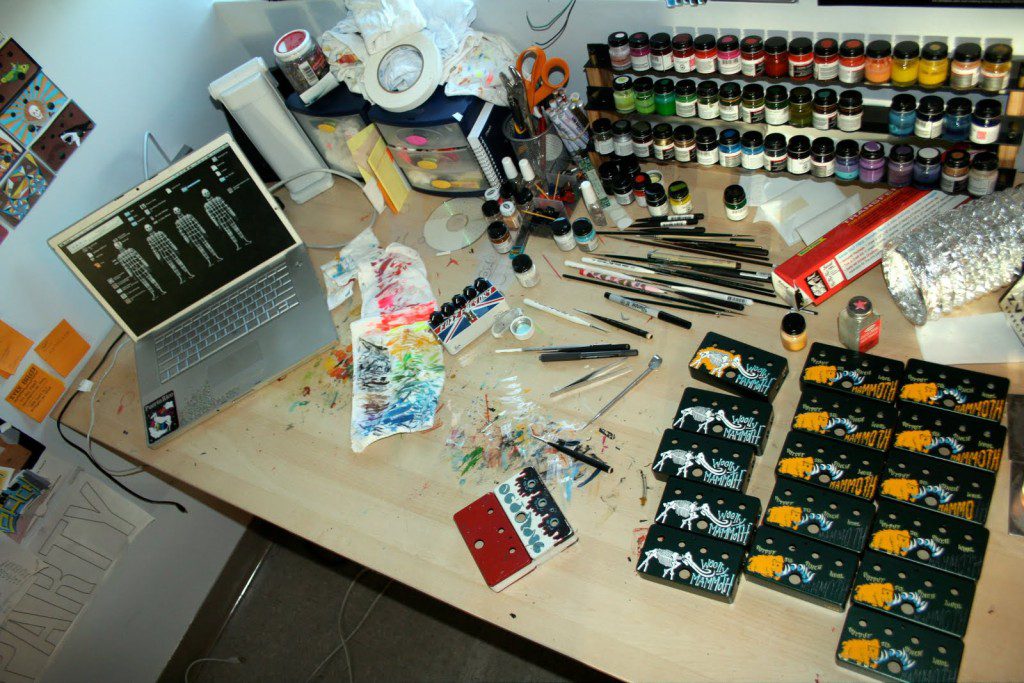 offs—like their dead dog on the pedal. We painted a lot of those, you know, kind of like a shrine. The pedals became precious personalized objects. Sometimes people also liked to match the album art to the pedals. We’ve painted pedals for Jack White and SUNN O))). I’ve also painted for J. Mascis, Nels Cline, and so many others. Sometimes it’s like a Jackson Pollack paint splatter, other times it’s intricate hand glittering, or something entirely different.
offs—like their dead dog on the pedal. We painted a lot of those, you know, kind of like a shrine. The pedals became precious personalized objects. Sometimes people also liked to match the album art to the pedals. We’ve painted pedals for Jack White and SUNN O))). I’ve also painted for J. Mascis, Nels Cline, and so many others. Sometimes it’s like a Jackson Pollack paint splatter, other times it’s intricate hand glittering, or something entirely different.
Rumpus: It sounds a lot like tattoo design.
Haugberg: Yes, it often is, especially when you’re re-appropriating images that are either found or supplied to you. I did some stuff for Ian Fowles for Yo Gabba Gabba, but if someone else asks me for a Yo Gabba Gabba pedal, I’m like, “Well, you know I can do something kind of similar, but you don’t own it.” But we actually did do a Where the Wild Things Are pedal. The guy who wanted it contacted the estate of Maurice Sendak, and they said yes to us recreating the art.
Rumpus: You’re bringing up some interesting questions about image ownership. Do you find that other artists have copied your designs or style?
Haugberg: A lot of people in the industry have borrowed from our style. There are now a couple of companies that do hand painting, though not really on our scale.
Rumpus: How many pedals have you painted so far?
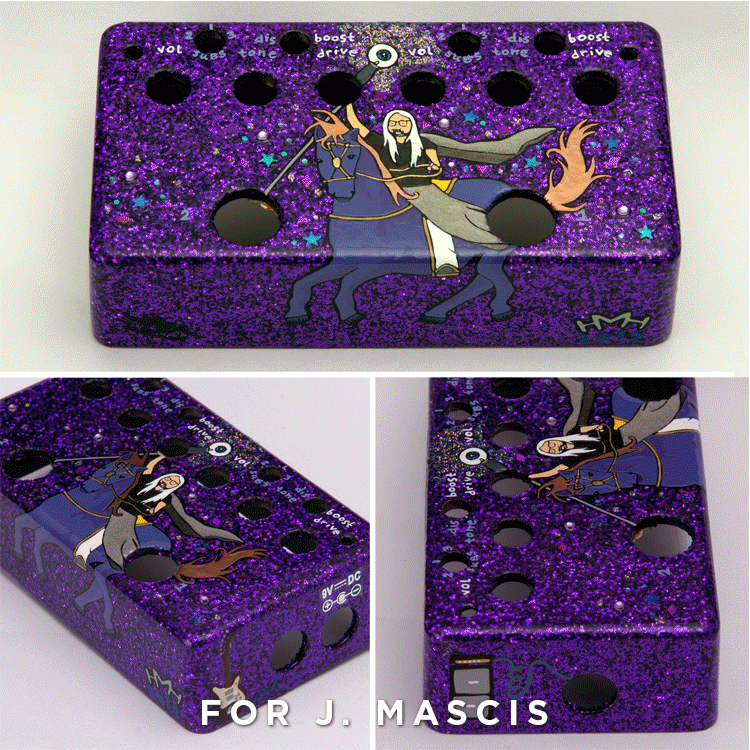 Haugberg: I have painted almost 4,000 pedals—I’d say I do about 650 a year. After the NAMM show, which is held each January, I have custom work booked solid for almost the next six months, and in addition to the custom orders I have tons of pedals just sitting out—maybe a hundred at a time—that I’ll just pick up and start painting, then get assembled, and they go up on the Z.Vex website, or people claim them through the custom web store.
Haugberg: I have painted almost 4,000 pedals—I’d say I do about 650 a year. After the NAMM show, which is held each January, I have custom work booked solid for almost the next six months, and in addition to the custom orders I have tons of pedals just sitting out—maybe a hundred at a time—that I’ll just pick up and start painting, then get assembled, and they go up on the Z.Vex website, or people claim them through the custom web store.
Rumpus: What are some of your most memorable designs?
Haugberg: I have documentation of every single pedal I’ve ever made and it’s amazing to look back. Lately I’ve been working with a musician called Scott Briggs. For one of his pedals he wanted me to draw two monsters knife fighting on a rooftop. He liked it so much he told me he’s naming his band after the pedal. I also once did a pedal for Sean Lennon after I had met his bandmate Yuka Honda. She told me she wanted me to make a pedal for her bandmate because his birthday was coming up. When she left my boyfriend was like, “Do you realize her bandmate is Sean Lennon?” I actually took a painting of his and recreated it, and he sent me an email saying, ”This is even better than the original!” I was like, “Oh my gosh!” It was really humbling to get that kind of praise. Whether or not a musician is famous, it’s so great to hear how much your work meant to them.
Rumpus: Now a technical question: Is it sometimes hard to get your designs to translate onto such a small amount of real estate, as you must with a guitar pedal? 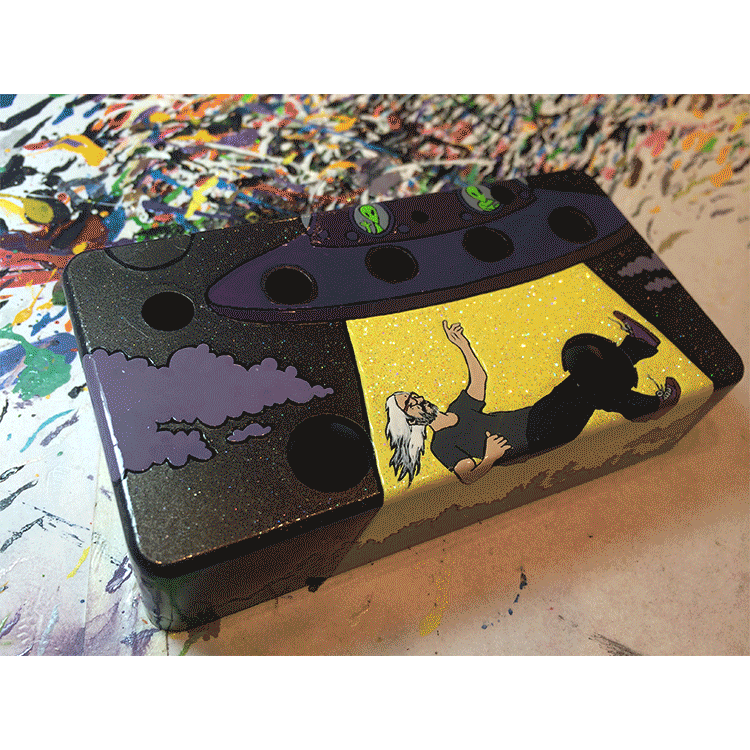
Haugberg: Yes. We actually expanded the line recently to include some larger pedals. Over the years I started painting around the sides and onto the knobs and incorporate the knobs into the design. If the knob is straight up at 12 o’clock then it completely bleeds into the image and gives me a little more space to work with.
Rumpus: Let’s talk about some of the design work you’ve done beyond guitar pedals.
Haugberg: Sure! I put together a site called Bored Only Child as a kind of craft alias. I get great pleasure out of working on something for like twelve hours at a time, getting in that flow. For example I make small papier-mâché guitars that I collage images onto. I do a lot of piñatas too—for example for a friend of mine who puts on an arts event called Cinco De Mayhem, which is huge and all-ages, and all of the money goes to charity. I’ve done random strange paint jobs too, which I’m really excited about.
Rumpus: I understand you’ve recently decided to leave Z. Vex to work on other projects. What’s next for you?
Haugberg: Well, I’m turning thirty, and I’ve worked for Z. Vex since I was twenty-two. I’m close with everyone there, and I’ll still do some custom work for the company, but I’m also eager to explore other creative opportunities. For example, I’m doing some work for Polaris Industries on the surface patterning of some of their vehicles that will be coming out in the next couple of years. I also have a couple of friends in the music industry that I’m working with on non-pedal projects like drum heads, speaker amps, and stuff like that. Everything borrows from itself. It just keeps going.
***
BONUS MATERIAL
The feature image for this interview shows Hannah with a 72 square foot mural she painted when she designed her “Sistine Chapel” pedal board back in 2012. Here are some additional views of the board—the first is the finished project and the second is a detail from the mural.
And here’s a custom pedal designed by Hannah in conjunction with a special exhibition called The Art of the Stompbox held in 2010 by the Museum of Making Music:
***
For more information about Hannah’s current Z. Vex pedals, click here.
***
All images © Hannah Haugberg.
***
This interview has been edited and condensed. If you’d like to recommend someone for “Sound & Vision,” drop Allyson a line here.

